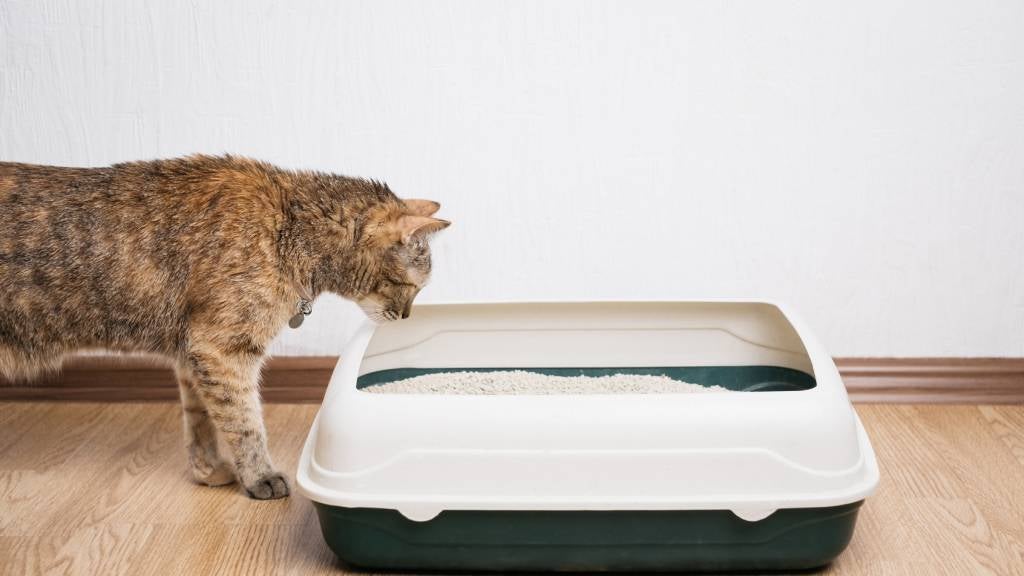What is cat spraying and how can you address this behaviour?

We’ve all experienced it – you come home to find your beloved cat has marked their territory. We know this can be frustrating, but help is at hand! Let's take a look at what cat marking is, why cats do it and how we can prevent it.
What is cat spraying
Cat spraying (also known as marking) is common behaviour, particularly for cats that are not neutered or spayed.
Contrary to popular belief, not just male cats will mark. Dr Rosalind Holland (BVSc) confirms that “this behaviour can be seen in both males and females”.
Spraying involves the cat releasing strong-smelling urine onto surfaces as an act of marking its territory, communicating with other cats, and leaving an olfactory trail. Dr Holland tells us that “urine marking is purposeful urination that is used to convey messages to other cats.”
Cats also have scent glands in their face, paws and tail which they use to mark objects, such as scratching posts or furniture and even people! This helps them feel safe in their environment.
They may spray for a variety of reasons, such as:
- Stress or anxiety
- New people, animals, or objects in the home
- Unneutered or unspayed
- Conflict between cats in a multi-cat household
- Competing territorial claims from other cats outside the home
- New cats outside the home
Marking vs Inappropriate elimination
Dr Holland adds that “if your cat is urinating where you don’t want them to, it is important to determine if the behaviour is marking behaviour or inappropriate elimination.”
“Inappropriate elimination is emptying of the bladder or bowels in locations other than the litter box whereas marking is usually passing smaller amounts of urine on vertical surfaces and doesn’t involve scratching or digging. Inappropriate elimination can be associated with medical issues so it is important to have a veterinary exam to check for any underlying illness that could be contributing”.
Some common causes of inappropriate elimination include:
- Medical problems such as urinary tract infections, kidney disease or bladder stones
- Stress or anxiety
- Changes in the home or routine
- Unmet toileting needs (e.g. not enough litter boxes for the number of cats, type of litter not favoured by the cat, too much or too little litter, litter box is enclosed or too small)
- Poor litter box maintenance (e.g. lack of regular cleaning)
- Incorrect placement of the litter box (e.g. litter box is in a high traffic area)
Whether your cat is spraying or urinating outside of the litter box, it is important to clean any messes with an enzymatic cleaner. Using other cleaning products will not fully remove the odours and will increase the likelihood that your cat repeats this behaviour in the same area.
Dr Holland’s top tips
The key to dealing with cat spraying in the home is to minimise stress levels. Manage your cat's environment and lifestyle to keep them calm and relaxed, as stressed cats are more likely to exhibit spraying behaviour. Here are six key tips provided by Dr Holland:
- Provide adequate resources for each cat: Keep adequate distance between food bowls during meal times, and consider feeding cats separately if needed. This can prevent territorial disputes and anxiety during feeding.
- Provide multiple litter boxes: Offer at least one more litter box than the number of cats in the household to minimise territorial disputes and ensure privacy for each cat.
- Create comfortable resting areas: Offer a variety of cosy, undisturbed spaces throughout the home where cats can relax, nap, and feel secure. Elevated spots or hiding places are especially beneficial.
- Spend quality time with each cat: Give individual attention to each cat to strengthen your bond and reassure them of their significance in the household.
- Block external stressors: Obstruct views that may cause stress or territorial tension, such as other cats outside the home. Use curtains, blinds, or frosted window film to prevent visual disturbances.
- Use cat pheromones: Diffusing synthetic cat pheromones, such as Feliway, throughout the living space can help create a calm environment and alleviate stress among cats.
Getting the right support
If you suspect your cat’s behaviour is due to a medical issue or it's getting too difficult to manage, Dr Holland recommends seeing a vet for extra support. “Vets can rule out medical causes, give extra advice, or assess whether medications may suit your cat.”
Your vet may also provide a referral to a behaviourist to help troubleshoot this behaviour.
Enjoy stress-free cat care
Reaching out for vet support should not be a financial burden. Pet insurance can help provide peace of mind for unexpected eligible vet bills for accidental injury and illness. With SPCA Pet Insurance you could be covered for up to 80% of eligible vet bills1 helping you to protect your feline friend. Love them, protect you!
30 May 2023
- Pre-existing conditions are excluded. Limits, sub-limits, and annual condition limits may apply. A $2,000 annual condition limit applies to Everyday Cover. Benefit percentage varies dependant on the level of cover selected.